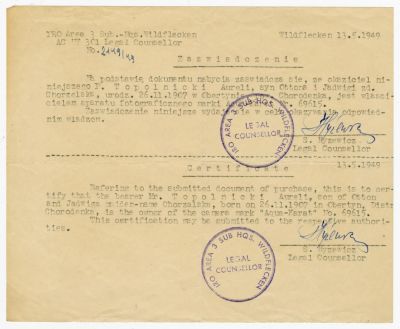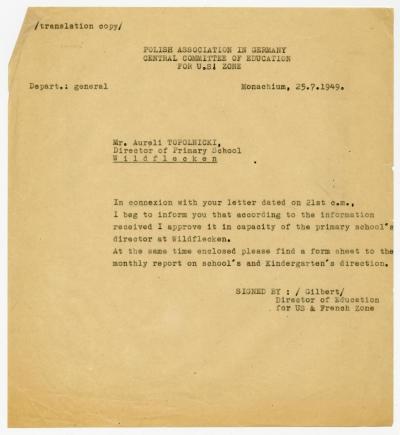The estate of Aureli Topolnicki, resident between 1945 and 1951 in the DP camp in Wildflecken (Durzyn)

Because of its size and diversity the estate of Aureli Topolnicki documenting his time as a displaced person cannot be too highly valued by historical research workers, especially with regard to its importance in describing everyday details and cultural events in the Wildflecken camp in the American occupying zone in Germany. The material allows us to reconstruct the life and experiences of Aureli Topolnicki in the years between the setting up of one of the largest Polish DP camps in Germany at the end of the war and its closure at the beginning of the 1950s. Hence the estate contributes to our understanding of the general living conditions in a major DP camp and the changes that occurred during this period, not forgetting the setting up of the administrative and cultural facilities by the camp’s independent administrative body. But above all, the contents of the estate allow us to use the Wildflecken DP camp as a concrete example of the foundation and development of schools and educational establishments for children, young people and adults. Furthermore the documents make clear the extent to which the desire to emigrate influenced the daily life of people in the camp and the difficult hurdles they had to overcome in order to give their families a new perspective abroad.
That the problem of displaced persons (DPs) was not a side issue in European post-war history is shown by the number of people affected. Immediately after the end of the war there were around 11,000,000 displaced persons from 20 states in the old area of the German Reich. 6,500,000 of these alone were living in the Western occupying zones. Even when most of these were repatriated to their home countries in 1945 – some voluntary and others against their will –there were still around 1,700,000 DPs living in the territory of occupied Germany at the start of 1946.[3] As the Cold War set in, the Western allies started to allow compulsory repatriation to the countries in Eastern Europe, a measure which many DPs vehemently opposed. By 1947 over 700,000 DPs of different nationalities were still stubbornly refusing to leave the Western occupying zones. From now on they were regarded as impossible to repatriate.[4]
Immediately after the end of the war the ca. 11,000,000 DPs on German territory contained around 1,700,000 Poles, of whom 700,000 were living in the Soviet zone from where they could be relatively quickly repatriated to Poland.[5] In the following two years a large majority of Polish DPs were indeed repatriated to Poland. Nonetheless the number of Polish DPs in the Western occupying zones was still around 190,000 in June 1947 (ca. 103,000 in the US zone, 76,000 in the British zone and 10,000 in the French zone).[6] These were mainly people who had categorically rejected a return to Poland on political or ideological grounds, or whose homes in Poland had been annexed to the Soviet Union or the Ukrainian Socialist Soviet Republic, and had not yet succeeded in finding a new home in other Western European states or overseas.
[3] Brandes, Detlev/Wiesemann, Falk: Displaced Persons, in: Brandes, Detlev/ Sundhaussen, Holm/Troebst, Stefan (eds): Lexikon der Vertreibungen. Deportation, Zwangsaussiedlung und ethnische Säuberung im Europa des 20. Jahrhunderts, Wien 2010, p. 212
[4] Ibid, p. 213.
[5] Loew, Peter Oliver: Wir Unsichtbaren. Geschichte der Polen in Deutschland, München 2014, p. 192.
[6] Brzoza, Czesław: Między repatriacją a emigracją. Polacy w Niemczech Zachodnich w latach 1945-1951 [Between Repatriation and Emigration. Poles in West Germany between 1945 and-1951], in: Paczyńska, Irena (ed.): Śląsk. Polska. Emigracja. Studia dedykowane Profesorowi Andrzejowi Pilchowi [Silesia, Poland, Emigration. Studies dedicated to Professor Andrzej Pilch], Kraków 2002, p. 296.









































![Document no. 35/1 Document no. 35/1 - Handwritten letter [in Polish] from M. Paledog from Cheltenham/England to A. Topolnicki.](/sites/default/files/styles/width_100_tiles/public/assets/images/12890-031-1a.jpg?itok=gfPskEix)
![Document no. 35/2 Document no. 35/2 - Handwritten letter from M. Paledog from Cheltenham/England to A. Topolnicki, [p. 2].](/sites/default/files/styles/width_100_tiles/public/assets/images/12890-031-1b.jpg?itok=Df4ctKpD)
![Document no. 36/1 Document no. 36/1 - Envelope to the letter [Document 35] from Paledog to Topolnicki.](/sites/default/files/styles/width_100_tiles/public/assets/images/12890-031-2a.jpg?itok=krd42nL9)
![Document no. 36/2 Document no. 36/2 - Back of the envelope to the letter [Document 35] from Paledog to Topolnicki.](/sites/default/files/styles/width_100_tiles/public/assets/images/12890-031-2b.jpg?itok=K_dTfhNe)

![Document no. 38 Document no. 38 - Topolnicki is informed about the progress of his immigration application [ assurance is recognised].](/sites/default/files/styles/width_100_tiles/public/assets/images/12890-033.jpg?itok=OKjuXvyn)
![Document no. 39 Document no. 39 - [Handwritten copy of the] birth certificate of Irma Saling, the wife of Aureli Topolnicki.](/sites/default/files/styles/width_100_tiles/public/assets/images/12890-034-1.jpg?itok=Qcvw5Oaz)











































































































































![Dokument Nr. 127/1 Dokument Nr. 127/1 - Personalausweis von A. Topolnicki mit Lichtbild und Informationen zur Person und Aussehen, zudem Information über die Deportation nach Lungenburg [Lundenburg] am 16.7.1943](/sites/default/files/styles/width_100_tiles/public/assets/images/12890-096a.jpg?itok=pKJpAuzw)
![Dokument Nr. 127/2 Dokument Nr. 127/2 - Personalausweis von A. Topolnicki mit Lichtbild und Informationen zur Person und Aussehen, zudem Information über die Deportation nach Lungenburg [Lundenburg] am 16.7.1943.](/sites/default/files/styles/width_100_tiles/public/assets/images/12890-097b.jpg?itok=RIjcT74Q)




















































